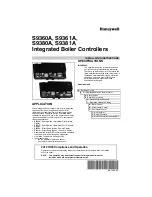
42
APPENDIX B – VENTING
VENT THIS BOILER according to the instructions. Failure to do so may cause products of
combustion to enter the building resulting in severe property damage, personal injury or death.
i
Install this boiler according to this manual and the National Fuel Gas Code, ANSI Z223.1/NFPA
54, or applicable provisions of the local building codes. Contact local building or fire officials about
restrictions and installation inspection in your area.
This Appendix consists of two sections (B2, and B3). Refer to the section appropriate for the type of boiler
you are installing or servicing.
B2 Direct Vent
“Direct vent” is also called “sealed combustion”. All combustion air is drawn from outside
the building directly into the boiler. The boiler vents vertically or horizontally, assisted by a fan in the
boiler. Gas vent must resist temperature and corrosion and be sealed against leakage of flue gases and
condensate. Approved materials include AL29-4C stainless steel. Combustion air provided by a separate
PVC or galvanized steel pipe.
B3 Power Vent
Similar to Direct Vent, but some or all combustion air is drawn from inside the building.
May draw air directly from the boiler room without the use of a combustion air pipe.
Vent connectors serving appliances vented by natural draft shall not be connected into any portion of
mechanical draft systems operating under positive pressure.
IF AN EXISTING BOILER IS REMOVED
When an existing boiler is removed from a common
venting system, the common venting system is
likely to be too large for proper venting of the
appliances remaining to it.
At the time of removal of an existing boiler,
the following steps shall be followed with each
appliance remaining connected to the common
venting system placed in operation, while the other
appliances remaining connected to the common
venting system are not in operation:
(1)
Seal any unused openings in the
common venting system.
(2)
Visually inspect the venting system
for proper size and horizontal pitch
and determine there is no blockage
or restriction, leakage, corrosion, and
other deficiencies which could cause an
unsafe condition.
(3)
Insofar as is practical, close all
building doors and windows and all
doors between the space in which the
appliances remaining connected to the
common venting system are located
and other spaces of the building. Turn
on clothes dryers and any appliance
not connected to the common venting
system. Turn on any exhaust fans, such
as range hoods and bathroom exhausts,
so they will operate at maxi mum speed.
Do not operate a summer exhaust fan.
Close fireplace dampers.
(4)
Place in operation the appliance
being inspected. Follow the Lighting
(or Operating) Instructions. Adjust
thermo stat so appliance will operate
continuously.
(5)
Test for spillage at the draft hood relief
opening after 5 minutes of main burner
operation. Use the flame of a match or
candle, or smoke from a cigarette, cigar
or pipe.
(6)
After it has been determined that each
appliance remain ing connected to the
common venting system properly vents
when tested as outlined above, return
doors, win dows, exhaust fans, fireplace
dampers and any other gas burning
appliance to their previous conditions of
use.
(7)
Any improper operation of the common
venting system should be corrected
so the installation conforms with the
National Fuel Gas Code
, ANSI Z223.1/
NFPA 54
.
When resizing any portion
of the common venting system, the
common venting system should be
resized to approach the minimum size as
determined using the appropriate tables
in Chapter 13 of the
National Fuel Gas
Code
, ANSI Z223.1/NFPA 54.
Summary of Contents for ESC
Page 7: ...7 Figure S 1 Minimum Clearances to Combustibles SPECIFICATIONS continued...
Page 20: ...20 Figure 10 d Operating Instructions 10 Perform Startup Checks and Adjustments continued...
Page 37: ...37 Internal Wiring Figure IW 1 Wiring Diagram...
Page 38: ...38 Internal Wiring continued Figure IW 2 Wiring Diagram...
















































